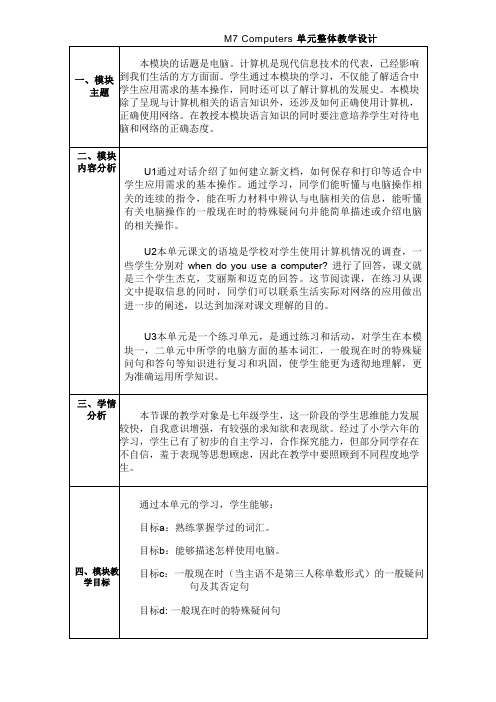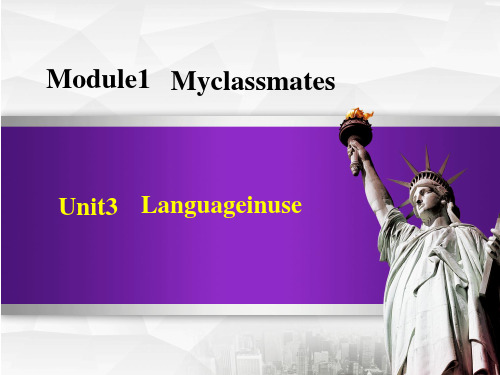外研版英语七年级上Module 5 Unit 3《Language in use》ppt课件
Module+6+Unit+3++Language+in+use 外研版英语七年级上册

三、一般疑问句的问答 当句子的主语是第三人称单数he/she/it、可数名词单数或者不可数名 词,且谓语动词是行为动词时,一般疑问句的结构是“Does+主语+动词 原 形 + 其 他 ? ” 。 回 答 用 “Yes, he/she/it + does.” 或 “ No, he/she/it + doesn't.”。如: —Does he like pandas? 他喜欢熊猫吗? —Yes, he does./No, he doesn't.是的,他喜欢。/不,他不喜欢。
A.回答问题 Jumbo is a big and strong elephant.He lives in a small village in India.He helps Dave carry(搬) heavy things and he works very hard.Dave always says he is a good elephant. On important days, Dave usually takes Jumbo to the town(镇).Jumbo gives(给) children rides on his back.
①The elephant lives in Africa and in Asia.大象生活在非洲和亚洲。
②It eats grass and leaves.它吃草和树叶。
二、否定句 当句子的主语是第三人称单数he/she/it、可数名词单数或者不可数名 词,且谓语动词是行为动词时,否定句的结构是“主语+doesn't/does not +动词原形+其他.”。如: ①The kangaroo doesn't eat meat.袋鼠不吃肉。 ②Peter doesn't like swimming.彼得不喜欢游泳。
外研版英语七年级上Module1Unit3Languageinuse课件

They’re our friends.
The use of “be”
Are you from America? Yes, I am. Is he Chinese? No, he isn’t. Are they in Class 1? No, they aren’t. They are not in Class 1.
3.
Is Xu Kexin from England?
No, she isn’t . She is from China .
4.
Is Xu Kexin in Class 3?
Yes, she
is .
Complete the conversation. (Activity 3)
Jack: Hi, my name is Jack. What’s your name?
Look at the pictures and introduce the three people to your class. (Activity 1)
This is Xu Kexin. She’s thirteen. She’s from China. She’s in Class 3.
Xu Kexin, thirteen, China, Class 3
How to introduce yourself and your friends?
I’m your teacher. My name is Li Daming.
She’s my friend.
Her English name is Lucy.
He’s from Shanghai. His English name is Henry.
外研社英语七年级上Module5Unit3课件

THANKS
感谢观看
04
teaching process
Import process
01
02
03
教学目标明确
教师需清晰地阐述本节课 的教学目标,以便学生了 解他们需要掌握的内容。
激活学生的前知
教师可以通过提问、讨论 等方式激活学生已有的英 语知识和经验,为新课做 准备。
导入新课
教师可以通过情境创设、 实物展示、故事讲述等方 式导入新课,激发学生的 学习兴趣。
Student performance evaluation
评价内容
评估学生在本单元中的学 习成果,包括词汇、语法、 阅读、写作和听力的掌握 情况。
评价方法
通过课堂测试、作业、小 组讨论和个人陈述等多种 方式进行评估。
反馈与指导
根据学生的表现,提供具 体的反馈和指导,帮助学 生找出不足并制定改进计 划。
通过课堂活动和小组讨论,培 养学生的口语表达和交际能力。
引导学生自主学习,培养其独 立思考和解决问题的能力。
Emotional goals
激发学生对英语学习的兴趣和热情, 培养积极的学习态度。
引导学生树立正确的价值观和世界观, 培养其良好的道德品质和社会责任感。
培养学生的自信心和自尊心,鼓励他 们在课堂上积极参与和展示自己。
Reflection and improvement
反思内容
总结本单元教学的得失,分析教学中存在的问题和不足,思考改 进的方法和措施。
改进方向
针对反思中发现的问题,制定具体的改进计划,包括调整教学内 容、改进教学方法、加强课堂管理等。
持续发展
将反思和改进作为教学过程中的常态,不断优化教学过程,提高 教学效果和学生的学习成果。
Module5Unit3Languageinuse课件七年级英语上册

预习导学
2)on 表示 具体某一天 或某一天的某段时间,如:on Monday 在周一,on March 7th在3月7日,on the morning of September 1st 在9月1日上午。 3)at 表示某个 具体时刻 。如:at eight o’clock 在8点钟。
词汇分类
合作探究
合作探究
●I go to school at half past seven in the morning. 我在早上七 点半去上学。
go to school意为“去上学”,其中的to不能少。但表示“回家” 只能用go home,因为副词home前不能加介词。例如:go to the park 去公园, go swimming 去游泳, go shopping 去购物
合作探究
3.根据你的个人情况,回答下列问题。 (1)What time do you get up?
(2)What time do you go to school?
(3)What time do you start work? (4)What time do you go to bed?
合作探究
预习导学
三、想一想 1.在含有行为动词的一般现在时态中,句子的主语是非第三人称 单数时,后面连用的行为动词用 原形 ,变否定句要在动词前 加 don’t (do和not的缩写)。一般疑问句在句首加 Do ,句 末的句点改问号,肯定答语: Yes, 主语+do ,否定答语: No, 主语+ don’t.
3.完成课本P31上的4。用at, in或 on填空。 4.完成课本P31上的5。用方框中所给的单词完成句子。
学习小助手
短语“在一个寒冷的冬天的早晨”用介词on翻译,因为时间涉 及了某一天的早晨,译为on a cold morning。
Unit+3+Language+in+use 大单元整体教学设计 外研版英语七年级上册

一、模块主题本模块的话题是电脑。
计算机是现代信息技术的代表,已经影响到我们生活的方方面面。
学生通过本模块的学习,不仅能了解适合中学生应用需求的基本操作,同时还可以了解计算机的发展史。
本模块除了呈现与计算机相关的语言知识外,还涉及如何正确使用计算机,正确使用网络。
在教授本模块语言知识的同时要注意培养学生对待电脑和网络的正确态度。
二、模块内容分析U1通过对话介绍了如何建立新文档,如何保存和打印等适合中学生应用需求的基本操作。
通过学习,同学们能听懂与电脑操作相关的连续的指令,能在听力材料中辨认与电脑相关的信息,能听懂有关电脑操作的一般现在时的特殊疑问句并能简单描述或介绍电脑的相关操作。
U2本单元课文的语境是学校对学生使用计算机情况的调查,一些学生分别对when do you use a computer? 进行了回答,课文就是三个学生杰克,艾丽斯和迈克的回答。
这节阅读课,在练习从课文中提取信息的同时,同学们可以联系生活实际对网络的应用做出进一步的阐述,以达到加深对课文理解的目的。
U3本单元是一个练习单元,是通过练习和活动,对学生在本模块一,二单元中所学的电脑方面的基本词汇,一般现在时的特殊疑问句和答句等知识进行复习和巩固,使学生能更为透彻地理解,更为准确运用所学知识。
三、学情分析本节课的教学对象是七年级学生,这一阶段的学生思维能力发展较快,自我意识增强,有较强的求知欲和表现欲。
经过了小学六年的学习,学生已有了初步的自主学习,合作探究能力,但部分同学存在不自信,羞于表现等思想顾虑,因此在教学中要照顾到不同程度地学生。
四、模块教学目标通过本单元的学习,学生能够:目标a:熟练掌握学过的词汇。
目标b:能够描述怎样使用电脑。
目标c:一般现在时(当主语不是第三人称单数形式)的一般疑问句及其否定句目标d: 一般现在时的特殊疑问句单元课时安排语篇课型第*课时U1听说课第一课时U2阅读课第二课时U3语法课第三课时第3课时教学设计一、课题Module 7 computers Unit 3 Language in use二、课型听说课口语法课口阅读课口写作课口其它课口三、教材分析:What---语篇主题和主要内容是通过练习和活动,对学生在本模块一,二单元中所学的电脑方面的基本词汇,一般现在时的特殊疑问句和答句等知识进行复习和巩固,使学生能更为透彻地理解,更为准确运用所学知识。
外研版七年级英语上册Module 3 Unit 3 Language in use课件

It's behind the science building.
3 Where is the playground? It's in the middle of the school.
be用复数还是单,与其主语很相关。 主语单数、不可数,则用is记清楚。 倘若复数作主语,用are一定要记住。 并列结构为主语,是is是are就近取。
用be动词的适当形式填空
(1)There____is____a basketball in the box. (2)There ___a_r_e___many birds in the tree. (3)There____is____ an orange and some bananas in the basket. (4)There ___a_r_e___some bananas and an orange in the basket.
课堂练习
一、用be动词的适当形式填空 1.There ___is__ a map and some pictures on the wall. 2.—___I_s__ there a library in your school?
—No,there __is_n_’_t__. 3.—___A_r_e___ there any students on the playground?
there be句型和have/has的区别
翻译 (1)桌子上有三本书。(2)我有三本书。 __(_1_)T__h_e_r_e_a_r_e_t_h_r_e_e_b_o_o_k_s__o_n_t_h_e_d_e_s_k_.____ __(_2_)I__h_a_v_e_t_h_r_e_e_b_o_o_k_s_._______________
外研版英语七年级上册Module 3 Unit 3《Language in use》教学设计

外研版英语七年级上册Module 3 Unit 3《Language in use》教学设计一. 教材分析外研版英语七年级上册Module 3 Unit 3《Language in use》主要介绍了日常生活中的常用表达法和交际用语。
本节课主要围绕购物、问路、打电话等场景展开,让学生在实际情境中学会用英语进行交流。
教材内容丰富,实用性强,有利于激发学生的学习兴趣和积极性。
二. 学情分析七年级的学生已经掌握了基本的英语语法和词汇,具备一定的听说读写能力。
但部分学生在实际口语交流中还存在一定的困难,如胆小、害羞、发音不准确等问题。
因此,在教学过程中,需要关注学生的心理素质和发音准确性,鼓励他们大胆开口说英语。
三. 教学目标1.知识目标:学生能够掌握日常生活中常用的表达法和交际用语,如购物、问路、打电话等。
2.能力目标:学生能够在实际情境中运用所学知识进行口语交流,提高口语表达能力。
3.情感目标:培养学生大胆开口说英语的信心和勇气,激发他们对英语学习的兴趣。
四. 教学重难点1.重点:学生能够熟练掌握日常生活中常用的表达法和交际用语。
2.难点:学生在实际情境中运用所学知识进行口语交流,提高口语表达能力。
五. 教学方法1.情境教学法:通过设置购物、问路、打电话等实际情境,让学生在情境中学习并运用英语。
2.任务型教学法:引导学生参与各种实际任务,如角色扮演、小组讨论等,提高学生的口语表达能力。
3.激励评价法:注重鼓励和表扬学生,激发他们的学习兴趣和自信心。
六. 教学准备1.教具:多媒体课件、录音机、磁带、角色扮演卡片等。
2.教材:外研版英语七年级上册Module 3 Unit 3《Language in use》。
3.课前准备:提前给学生发放角色扮演卡片,让他们熟悉角色和对话内容。
七. 教学过程1.导入(5分钟)利用多媒体课件展示一幅购物场景的图片,引导学生谈论图片中的物品和价格,激发学生的学习兴趣。
2.呈现(10分钟)教师展示本节课的主要内容,如购物、问路、打电话等场景的交际用语。
七年级英语上册M3MyschoolUnit3Languageinuse教案外研版(1)

初中英语教学、学习资料Book 1 Module3 My school一、教学内容:Unit3 Language in use二、课型:Revision and application三、教学目标:1. 能掌握并正确运用本模块的词汇。
2. 能掌握“there be”句型的肯定、否定、一般疑问及特殊疑问句式和相应的回答.能运用此句型来介绍事物。
3. 能正确使用表示方位的介词来描述物体的位置关系。
4. 提高学习英语兴趣,树立信心,培养其积极主动参与各种语言实践活动的学习态度。
四、教学重难点:能运用“there be”句型及表方位的介词来描述介绍的学校情况。
五、教学准备:本节课型为Revision and application,根据新课标的要求,结合教材和学生特点,主要采用任务型互动式进行教学,结合情景法、交际法、听说法、归纳法等教学方法实施课堂活动,开启学生思维,通过一系列有条理的教学活动,引导学生自主探究学习和与他人互动合作学习,让学生体验愉快学习。
本节课所需教具及资料:幻灯、图片等。
六、教学过程:教学步骤教师活动学生活动活动目的1. Leading-in (8’) 1. Ask the Ss:What’s the topic ofthis module?What’s in theschool?Show and get the Ss tocomplete the wordmap in Activity 3.2. Get the Ss to talkabout their school.And write some keystructures sentenceson the blackboard.1. Answer the teacher’squestions and complete theword map.2. Talk about their schoolwith the words on the wordmap.e.g. Is there a library inyour school?Where is it?How many books are there init?Review and consolidatethe sentences whichthey have learned.初中英语教学、学习资料2.While-task 2. Let the studentsdo Activity 2 andthen check theanswers.3.Ask students toread “Around theworld”, and thenanswer the questionsafter reading.2. Do Activity 2 and checkthe answers.3.Read “Around theworld”, and answer thequestions after reading.Consolidate theprepositions of placeEnlarge the knowledgeabout the world.3. Post-task (10’)1.Ask students towork in groups:Draw a map ofyour school.2.Ask the studentsto introduce theirschool.3.Let students dosome ex ercises andthen check.1.Work in groups:Draw a map of their school2.Introduce theirschool.3. Do some exercises and thencheck.1.To practice the skillof speaking.2. Enable students totalk about their idealschool.3.Practice thelanguage points.4. Summary (1’)Ask the students tosay out what theyhave learned.Students conclude theknowledge that they havelearned.Let the studentsinternalize thegrammar they’velearned in this module.5. Homework (1’)Draw a map of your ideal school and write a passage about your ideal school.板书设计Unit 3 Language in useIs there a library in our school? Y es, there is.The library is behind the on the left of the playground.How many books are there in the library?There are …达标训练题I.句型转换。
2019秋外研版七年级英语上册课件:Module 5 My school day Unit 3

二、单项填空。
(D )1. We have ____ English class ____ Monday morning.
A.Aan; in B. a; on C. a; in D. an; on ( )2. We have geography ____ two o’clock in
the afternoon.
There are four lessons in the morning. The morning classes are over at eleven fifty,and he has lunch ten minutes later.
The afternoon classes begin at one thirty. There are two lessons in the afternoon. They are over at three ten. Tom stays at school for another hour to play games with his classmates,and he gets home at about four thirty.
The place Tom is staying inBeij1in. g_____________
now
leave home
The thing Tom does at 7:15(at)122. :_0_0___________
The time when Tom has
3. _____________
4. I _d_o_n_’_t_h_a_v_e_____. 5. We d_o_n__’t_r_e_a_d______(not read)in the library.
外研版七(上)英语ModuleUnit5PPT课件

Listen to music
often
Go shopping
sometimes
— Does Grandpa always watch TV? —Yes, he does.
2 Complete the table in Activity 1 about yourself. Now work in pairs. Ask and answer.
3. — Do you often exercise in the morning, Li Hua? — No, ________. I don’t like sports at all. A. often B. usually C.always D. never
4. Meals are very boring. He ________ has the same thing to eat every day. A.never B. usually C. sometimes D. seldom
表示频度方面的区别
1. always是频度最大的词,“总是;永远;一直”。 例:我将永远记住我上学的第一天。 I always remember my first day at school. usually “通常”,即很少例外,频度仅次于 always。 例:你通常早餐吃什么? What do you usually have for breakfast?
birthday party? 4 We sometimes give birthday cards. 6 My mother never makes a birthday cake.
100%
频度副词大家族
always
usually often
外研版-七年级上册讲义-教师版-Module5

Module 5 My school day【新手目标】通过本关,你能够学会时间及学科表达。
★★☆☆☆☆关卡1 Unit 1 I love history.【过关笔记】1 Reading and vocabularyHalf past o’clock past toArt Chinese English geography history IT maths PE2 Listen and readTony:Betty,what are our lessons on Monday?Betty:We have Chinese at eight o'clock and science at five to nine.At twenty past ten we have IT.Then we have maths.Do you like maths,Tony?Tony:Yes,I do,but it's difficult!I like the lessons on Monday afternoon:English and art.What lessons do we have on Friday?Betty:We have English,Chinese,PE and geography.Tony:And in the afternoon?Do we have maths?Betty:No,we don't.We have art and history,but we don't have maths.I love history and I'm goodat it.It's my favourite subject because it's very interesting.Tony:My favourite subject is Chinese.I can talk with my Chinese friends.【成长例题】连词成句例题1 homework, we, every, day, school, after, do_________________________________________________.例题2 play, they, at, in, three, afternoon, o’clock, the, football_________________________________________________.例题3 Sunday, don't, they, to, on, school, go_________________________________________________.例题4 start, our, eight, classes, in, at, morning, o’clock, the._________________________________________________.例题5 Saturday, Jack, play, does, football, on_________________________________________________?答案:1. We do homework after school every day2. They play football at three o' clock in the afternoon3. They don't go to school on Sunday4. Our classes start at eight o'clock in the morning5. Does Jack play football on Saturday【过关练习】用所给词的适当形式填空练习1 Betty and I ________ (drink) much water every day.练习2 Uncle Zhang like ________ (make) model planes.练习3 ________ the children often ________ (play) basketball on the playground?练习4 How about ________ (get) to school at seven tomorrow morning?练习5 She ________ (go) to learn French from 18:00 to 19:00 on Wednesday.答案:1. drink 2. making 3. Do,play 4. getting 5. goes【过关练习】根据汉语完成句子练习1 玲玲和贝蒂下午上化学和历史课。
外研版七年级英语上册(课件):Module 5

Unit 1 I love history.
第一课时 Getting ready & vocabulary
课前导学
核心单词
1. ________ n. 一半 half past 2. ________ prep. 晚于,过(几点) 3. ________ o'clock adv. ……点钟 4. geography ________ n. 地理 5. ________ lesson n. (一节)课 6. difficult ________ adj. 困难的,难懂的 7. ________ because conj. 因为 8.interesting ________ adj. 有趣的 9. ________ v. 谈论,说话 talk 10. ________ adv. 什么时候,何时 when
常用句型精讲 句型“What's the time?”的用法 【教材例句】What's the time? 现在几点了?(教材第
26页)
【用法】句型“What's the time?”用来询问当前的时间,
等于“What time is it?”。答语:It's+时间.
【举例】—What time is it now? 现在几点了?
【应用】 ( A )1. Daming is talking ________ Lingling. A. with B. on C. in D. of ( A )2. They are talking ________ the festivals
in America.
A. about B. to C. with D. /
易混词 (组) 辨析
外研版英语七年级上第五模块教材分析-精品文档

英语中还有一些用来表示数量多少的词汇,用来修饰名词时, 用法如下:
a little, little, much修饰不可数名词;a(n), many, few, a few, one修饰可数名词;a lot of , lots of, some, any 修饰可数与不 可数名词。
2. some 和any的区别
七年级(上)教材分析
Module5 Healthy food
一.教学内容分析
本模块的话题是饮食,是学生比较感兴趣的话 题。挑食、吃零食在学生中是种比较普遍的现 象。随着人们生活水平的提高,人们所吃的东 西、所了解的东西也越来越多,一些国外的食 品、水果等也为中国学生所熟知和食用。饮食 话题符合学生的年龄特点,而且中学阶段的学 生对健康饮食了解相对较少,因此有必要培养 其健康饮食的习惯。
Exercises
Module5 Healthy food
Module task: Making a food and drink poster.
语法讲堂:1.可数名词与不可数名词
条件 构成方法 例词
一般情况
以s, x, ch, sh等结尾 的名词
加-s
加-es
books, cats
watches, classes, boxes family-families Knife-knives hero—heroes photo--photos
二.学情分析 这是一个学生比较感兴趣的话 题,符合学生的年龄特点,让 学生学会各种食品英文表达的 同时学会健康饮食。
三.教学目标 1.语言知识目标
2.语言技能目标
3.学习策略目标 4.文化意识目标
5.情感态度目标
语言知识目标
词汇 healthy, orange, drink, fruit, vegetable, beef, carrot, chicken, juice, melon milk, onion, pork, potato, tomato, coke 介绍健康食品。 have/has got 表示“有”;some和any 的 用法;名词单复数。
外研版七年级英语上册教案Module 3Unit 3 Language in use

Unit 3 Language in use教学过程环节1 新课导入T: There are thirty students in my class.Are there computers on everyone’s desk?Ss: No, there aren’t.T: Is there a map of the world?Ss: No, there isn’t.How many students are there in your class?The library is on the left of the playground.设计意图:通过问答的方式复习上节课所学的知识,巩固“there be”句式的学习。
环节21. 学生两人一组进行问答。
2. 教师点名小组展示。
3. 学生个体准备并核对答案。
4. 学生个体活动,完成短文。
5. 教师提问,核对答案。
6. 学生朗读短文。
7. 学生独立完成词汇图并全班检査。
8. 3-4人一组,组内合作,丰富词汇图。
请学生展示新补充的词汇。
9. 学生自主完成活动4。
10. 从方框中选出合适的词来加以描述。
11. 用本模块所学的方位词来写一篇描写学校的短文。
12. 要点点拨1. Between the building and the dining hall is the classroom building with twenty-four classrooms.between是一个介词,常和and连用。
构成短语between…and…,表示“在……和……之间”。
I sit between Tom and Lucy .在本句中, with也是一个介词, 意思是“有”, 表示一种附属关系。
My friend has a house with a big garden.2. In the middle of the school is a big playground.in the middle of 表示“在……的中间”。
初三英语(外研版)M5 Unit 3 Language in use

Listen and express each floor.
③
the top floor
②
the second floor
the ground floor
①
Listen and label the parts of the museum. (Activity 8)
a) Ancient World b) A special room c) Modern World d) Natural World e) Restaurant f ) Ticket Office g) Toilet
Ask and answer questions about the museum. (Activity 5)
4. What rules are there?
There are many rules. No shouting, no food, no smoking, no pets and no littering.
2. If you want to know where you are, ask someone.
Complete the sentences with your own ideas. (Activity 4)
3. If you cannot arrive at the station on time, call your friends and let them know.
1. Describe the museum: What kind of museum it is. What you can see there. …
for visitors. (Activity 5)
1. If you want to visit the museum, don’t arrive after 5 pm.
外研版英语七年级上册M3 My new school Unit 3 Language in use教案附达标练习题及答案

初一上册G7M3U3 教学设计Module3 My new school内容简析:本模块以学校为话题介绍there be 句式的使用,对大部分学生来说,其所在学校是新学校通过种种句式以学校的设置和教室的状况进行介绍,教师也可根据学生的情况扩展话题,便于开展活动.目标定位:本单元的教学重点和难点是学生能熟练地利用there be句型介绍自己的班级和学校.能自如地运用所学英语进行交流,将输入的语言信息在一定的语境下合理输出,能自然地运用英文交谈.语言知识目标:1.掌握there be 句型的陈述句,否定句,一般疑问形式及回答。
2.学会运用表地点的介词:behind , in front of , next to ,3.名词所有格表所有关系的“’”语言技能目标:1:能利用there be句型介绍自己的班级和学校,并能正确运用缩写形式。
能参考图片介绍建筑物的位置关系。
2:能面向全班同学做有关学校介绍的欢迎辞情感态度:培养学生热爱学校,热爱自己的家园。
学习策略:培养学生利用图片联想词汇的习惯。
能借助词汇图掌握单词。
恰当运用多媒体辅助教学,运用网络视频,音频等素材,设置情境,模拟真实意义的活动.教学流程:环节一:Warming up An English SpeechTeachers’ Activity: Ask 3-5 students introduce their classroom .Students’ Activity: 3-5 student give an English speech about the classroom . Other studentslisten and find the mistakes. They can also ask the reporter any questionsabout the classroom .设计意图:,以演讲形式开始新课, 激发学生学习兴趣. 为进一步的交流与训练打下基础环节二:In putTeacher’s Activity:1.Show a map of the school (教师可自制简易地图) Ask : Where is the library / science lab/dininghall/gym….? Where are the offices/ classrooms …?2.Let the students describe the buildings’ place in the map .3.Ask the students to do Activity 2 . Then check the answers .Students’ Activity:1. Answe r the teacher’s questions.2. Describe the map in group of 4 .3.Do activity 2 ,complete the sentences by themselves . Then check the answer in pairs ..设计意图:通过问答练习,让学生用英语语言进行交流,并进一步熟悉和巩固以前学习的有关介绍位置关系的表达,充分训练本单元的语言功能项目.环节三: PracticeTeachers’ Activity: 小小设计师let the students draw a map of a new school in the future and describe it .Students’ Activity: 1:Design the map and write sentences near the buildings .2.Introduce the map to other members in their group.(评出最佳设计奖并推荐展评.)设计意图:以小组为单位,运用所学语言结构作解说,巩固刚刚学习过的语言结构,使学生掌握和流畅地使用目标语言。
2018年外研版七年级英语上册教学课件:Module 5 Unit 3 (共29页)

陈述句: They have an English class today. 否定句:
They don’t have an English class today.
疑问句: Do they have an English class today?
陈述句:We go to school from Monday to Friday. 否定句:We don’t go to school from Monday to Friday.
at, in, on的用法
1. 在表示地点方面, at + 点, on + 面, in + 内。 如: at the table“在桌子旁”, 强调的是具体的
地点;
on the chair“在椅子上”, 与椅子的面有接
触,强调接触面;
in the room"在房间里", 强调内部空间。
2. 在表示时间方面, in表示时间段, 即在较长
的一段时间内,如:
in the afternoon, i96
at通常表示时间点, 如: at six o’clock。
on表示具体的某一天或某天的某个时间,
如: on Sunday, on Monday afternoon, on a cold winter morning, on my birthday。
3. 在有些时间短语中, at可以表示时间段, 如: at night, at Christmas
Practice
用介词at, in, on填空。 at 1. The football match is ________ Dalian Stadium. on the bed. 2. My coat is ______
外研版七年级上册英语M5 My school day Unit 3 Language in use

考点2 表示主语的特征、性格或能力等。 eg:Welovesports.我们喜欢运动。
典例 他们说英语。 _T_h_e_y_s_p_e_a_k_E_n_g_l_i_sh_._______________________
classes______C__.(福州)
A.interested
B.interest
C.interesting
【点拨】此题用分析比较法。句意:——我们都喜欢王老 师。——我同意你的观点。她总是使她的英语课有趣。 interested修饰人,interesting则修饰物。故选C。
知识点 3 finish/'fInIʃ/v.完成;结束;用尽
Languagepractice WehaveChineseateighto'clock. Wedon'thavemaths. Doyoulikemaths? Yes,Ido. Intheevening,IwatchTVandhavedinnerwithmyfamily.
语法讲解
行为动词的一般现在时 (1)
ModuleM5 yschoolday
Unit3 Languageinuse
同学们,上一课学习的单词你们都掌握了吗?现在大家 来检验一下,点击下面的音频开始听写吧!
根据汉语,完成句子。 1.我们在八点钟上语文课。 ___W__e_h_a_v_e___Chineseateighto’colck. 2.我们不上数学课。
(3)____________
,
havebreakfast havelunch startwo and (4)__________ateight.
外研版七年级上册英语M1 Unit 3 Language in use

given name/ first name
family name given name
family name /last name
典例 MyfamilynameisGreenandmygivennameisJack. ________ismAyfullname. A. JackGreenB. GreenJack C. JackgreenD. Greenjack
__________?
Howold
Lingling:
I'mfromChina.(4)________________areyou?
Jack:I'mthirteen. Howoldareyou?
Lingling:I'm (5)t_h_i_r_te_e_n__too. I&#_Grade7.Whataboutyou?
am
I________fromChinaanadmI________anactor(演员).
2.This___i_s____mybrother. Hisname___i_s____Bob.
We_______a_raellfromEngland.
HeandTaorme________inthesameschool.
discussion
6
Workinpairs. Introduceyourself. Askandanswer. Hello,myname's... I'm...yearsold. I'mfrom... What'syourname? Howoldareyou? Whereareyoufrom?
知识点 1 InEnglish, thegivennameisfirstandthefamilynameis
- 1、下载文档前请自行甄别文档内容的完整性,平台不提供额外的编辑、内容补充、找答案等附加服务。
- 2、"仅部分预览"的文档,不可在线预览部分如存在完整性等问题,可反馈申请退款(可完整预览的文档不适用该条件!)。
- 3、如文档侵犯您的权益,请联系客服反馈,我们会尽快为您处理(人工客服工作时间:9:00-18:30)。
例如: 12:05—— five past twelve 9:50——ten to ten 8:40——twenty to nine 如果分钟是15,一般用a quarter 来代替 fifteen; 如果分钟是30, 一般用half来代 替thirty。例如: 9:15——a quarter past nine 11:30——half past eleven 2:45——a quarter to three
课堂讲练互动
2.Match the words in Column A with the words and expressions in Column B. A B 1 have a) dinner b) your homework c) to school 2 do d) a break e) an English lesson f) to bed 3 go g) home
Module 5 My school day
课堂讲练互动
Unit 3 Language in use
课堂讲练互动
课堂讲练互动
课堂讲练互动
课堂讲练互动
课堂讲练互动
课堂讲练互动
课堂讲练互动
时间的表达法 如果时间是半小时以内的,一般用几 点过几分的表达方式,如“…past…” e g. 5:10 ten past five
课堂讲练互动
用英语写出下列时间 six o’clock 6:00 ______________ five thirty half past five 5:30_____________\________________ eight ten ten past eight 8:10 _____________\________________ seven twenty twenty past seven 7:20 _____________\________________ nine fifty ten to ten 9:50 _____________\________________ forty twenty to eleven 10:40 ten ____________\________________ four fifteen a quarter past four 4:15 ______________\_______________ three forty-five a quarter to four 3:45 ______________\_______________
课堂讲练互动
行为动词的一般现在时
表达经常性或者习惯性的动作,就要 使用一般现在时。如: I do my homework in the evening. 我 在晚上做作业。 如果表示的是现在的状态,也可以用 一般现在时。如: I know him very well. 我和他很熟。
课堂讲练互动
第一人称和第二人称的一般现在时其 谓语动词没有形式的变化,否定形式 一般是在谓语动词前加don’t。如:I don’t go to school on Sunday. I go to the park on Sunday. 我周日不 去学校,去公园。
课堂讲练互动
I go to school at half past seven in the morning.
课堂讲练互动
Make phrases with do, have or go. 1. ______ have dinner 2. ______ do your homework 3. ______to school go 4. ______ have a break 5. ______ have an English lesson 6. ______ do housework 7. ______ go to bed 8. ______ go home
课堂讲练互动
I don’t go to school on Sunday. I go to the park on Sunday.
课堂讲练互动
1. 时间的表达方式。 1) 直接表示时间法:就是按照几点几分 的顺序来表示时间。(这个最简单)例 如: 8:00——eight o’clock 5:20——five twenty 2) 添加介词表示法:如果分数小于或等 于30,就用past来表示,结构是“分钟 +past+该点钟”;如果分钟大于30,就 用to来表示,结构是“分钟+to+下一点 钟”
课堂讲练互动
and (4) ___________at start work eight. There are four lessons in the morning. At twenty to ten, we (5) ______________for twenty have a break minutes. We go to the playground and I have lunch talk with my friends. We (6) __________ in the school dining hall. In the afternoon, we have two lessons and go home at half past three. I don’t (7) _____________ do homework on Friday evening. I do it on Saturday.
如果时间超过半小时,则用还差几分 到几点的表达方式,如“…to…”
e g. 6:40 twenty to seven
课堂讲练互动
We have Chinese at eight o’clock. We don’t have maths. Do you like maths? Yes, I do. In the evening, I watch TV and
课堂讲练互动
plete the passage with the expressions from the box.
do homework get up go to school have a break have breakfast have lunch start work
On Friday I have a busy day. I (1)_________at half past six in the get up morning. Then I wash my hands and face, and (2)______________at have breakfast seven. At half past seven, I (3)___________, go to school
